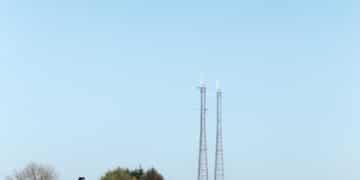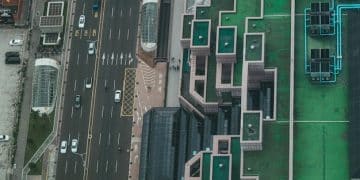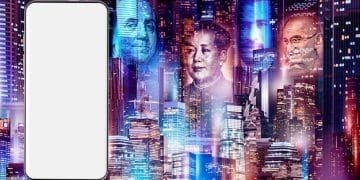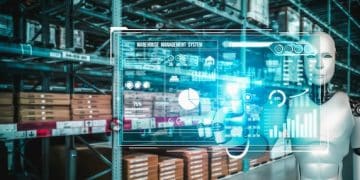US Smart Cities: How IoT is Transforming Urban Living by 2030
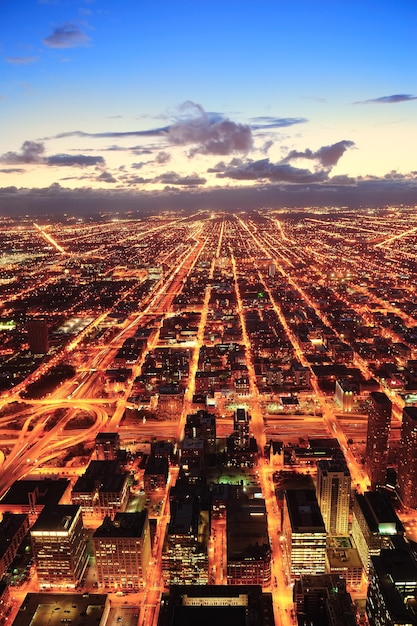
By 2030, the Internet of Things (IoT) is poised to revolutionize urban living in US smart cities through enhanced infrastructure, efficient resource management, and improved quality of life for residents.
The rise of US Smart Cities: How IoT is Transforming Urban Living by 2030 isn’t just a futuristic fantasy; it’s a rapidly approaching reality. Imagine a city that anticipates your needs, optimizes resources in real-time, and enhances your overall quality of life. This is the promise of the Internet of Things (IoT) in the urban landscape, and the US is at the forefront of this transformation.
The Dawn of US Smart Cities: An IoT Revolution
Smart cities are urban areas leveraging technology to improve the lives of their citizens. The Internet of Things (IoT) is the backbone of this transformation, connecting devices, systems, and people through data exchange.
But how exactly is IoT reshaping urban life in the US, and what can we expect by 2030?
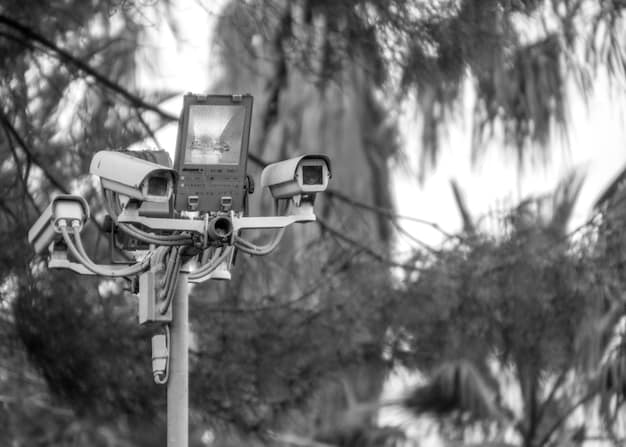
Key Components of IoT in Smart Cities
Several key components make up the foundation of IoT in smart cities. These elements work together to create a connected and responsive urban environment.
- Sensors: These devices collect data on various aspects of city life, from traffic flow to air quality.
- Connectivity: Reliable networks, including 5G and Wi-Fi, ensure seamless data transmission between devices.
- Data Analytics: Advanced algorithms analyze the collected data to identify patterns, trends, and opportunities for optimization.
- Cloud Computing: Cloud platforms provide the infrastructure for storing, processing, and managing the vast amounts of data generated by IoT devices.
These components are essential for creating a smart city ecosystem that can adapt to the changing needs of its residents.
In summary, the integration of IoT is not just about technology, but about creating more efficient, sustainable, and livable urban spaces for everyone.
Smart Transportation: Easing Congestion and Improving Mobility
One of the most visible impacts of IoT in smart cities is the transformation of transportation systems. From smart traffic management to connected vehicles, IoT is paving the way for smoother, safer, and more efficient commutes.
Here are some key applications of IoT in smart transportation:
Smart Traffic Management
IoT-enabled sensors and cameras monitor traffic flow in real-time, allowing traffic signals to adjust dynamically to optimize traffic flow and reduce congestion.
Connected Vehicles
Vehicles equipped with IoT sensors can communicate with each other and with the surrounding infrastructure, providing drivers with real-time information on traffic conditions, potential hazards, and optimal routes.
Smart Parking
IoT sensors can detect available parking spaces and provide drivers with real-time information, reducing time spent searching for parking and minimizing congestion.
These smart transportation solutions are significantly reducing gridlock and improving overall mobility. As cities continue to adopt and refine these technologies, residents can expect even greater improvements in their daily commutes.
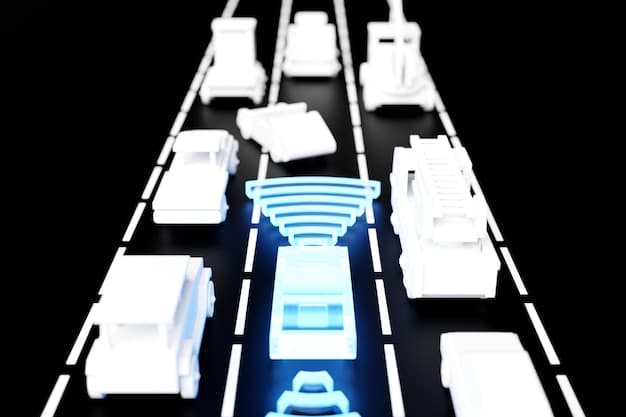
In conclusion, the integration of IoT is revolutionizing urban transportation, resulting in more efficient, safer, and convenient mobility solutions for city residents.
Sustainable Urban Living: IoT for Resource Management
Sustainability is a key priority for modern cities, and IoT is playing a critical role in optimizing resource management and reducing environmental impact.
Here’s how IoT is contributing to sustainable urban living:
- Smart Energy Grids: IoT devices monitor energy consumption in real-time, enabling utilities to optimize energy distribution and reduce waste.
- Water Management: IoT sensors detect leaks and monitor water usage, helping cities conserve water resources and prevent water shortages.
- Waste Management: IoT-enabled waste bins monitor fill levels and optimize collection routes, reducing fuel consumption and greenhouse gas emissions.
These IoT applications are not only improving resource efficiency but also reducing the carbon footprint of cities.
In essence, IoT is revolutionizing urban sustainability by enabling cities to manage their resources more efficiently, reduce waste, and create a greener, more livable environment for residents.
Enhanced Public Safety: IoT for Emergency Response
Public safety is paramount for any city, and IoT is enhancing security measures and improving emergency response times. From crime prevention to disaster management, IoT is empowering cities to protect their citizens more effectively.
Smart Surveillance
IoT-enabled cameras and sensors monitor public spaces, providing real-time surveillance and helping to prevent crime.
Emergency Response
IoT devices enable first responders to quickly assess situations, coordinate resources, and provide assistance to those in need.
Disaster Management
IoT sensors monitor environmental conditions, such as flood levels and air quality, providing early warnings of potential disasters and enabling timely evacuations.
From detecting potential threats to coordinating emergency responses, IoT is paving the way for safer and more secure urban environments.
In summary, the integration of IoT is enhancing public safety by providing cities with real-time situational awareness and improved emergency response capabilities.
Healthcare Transformation: IoT for Remote Monitoring and Personalized Care
The healthcare sector is also experiencing a significant transformation thanks to IoT, with applications ranging from remote patient monitoring to personalized care.
Here are some key applications of IoT in healthcare:
- Remote Patient Monitoring: Wearable devices and sensors monitor patients’ vital signs and health conditions remotely, enabling healthcare providers to intervene proactively and prevent complications.
- Smart Hospitals: IoT devices automate tasks, track equipment, and improve patient flow, streamlining hospital operations and enhancing the quality of care.
- Personalized Care: IoT-enabled devices provide patients with personalized recommendations and support, empowering them to take control of their health and well-being.
These IoT applications are transforming healthcare delivery, making it more accessible, efficient, and patient-centered.
In short, IoT is revolutionizing healthcare by enabling remote monitoring, automating tasks, and delivering personalized care, ultimately improving patient outcomes and enhancing the overall healthcare experience.
Challenges and Opportunities: Navigating the Future of US Smart Cities
While the potential benefits of IoT in smart cities are immense, there are also challenges that need to be addressed to ensure successful implementation and widespread adoption.
Some of the key challenges include:
Data Security and Privacy
As cities collect and analyze vast amounts of personal data, ensuring data security and protecting citizens’ privacy is paramount.
Interoperability
Ensuring that different IoT devices and systems can communicate with each other seamlessly is essential for creating a truly connected smart city ecosystem.
Infrastructure Investment
Building the necessary infrastructure, including high-speed networks and data centers, requires significant investment.
However, overcoming these challenges also presents opportunities for innovation and economic growth. By addressing these issues proactively, cities can unlock the full potential of IoT and create a brighter future for their residents.
| Key Point | Brief Description |
|---|---|
| 💡 Smart Transportation | IoT optimizes traffic flow, parking, and public transit. |
| 💧 Sustainable Living | IoT manages energy, water, and waste efficiently. |
| 🛡️ Public Safety | IoT enhances surveillance and emergency response. |
| 🏥 Healthcare | IoT enables personalized care and remote monitoring. |
Frequently Asked Questions
▼
A smart city uses technology, particularly the Internet of Things (IoT), to enhance the quality and performance of urban services like energy, transportation, and utilities to improve the lives of its citizens.
▼
IoT improves transportation through real-time traffic monitoring, smart traffic lights that adjust to flow, and connected vehicles that communicate with infrastructure for safer, more efficient routes.
▼
IoT enables efficient management of resources like energy and water, tracking usage and detecting waste, helping cities reduce their environmental impact and become more sustainable.
▼
IoT-enabled surveillance systems monitor public spaces, helping prevent crime. IoT also improves emergency response by quickly assessing and coordinating resources during emergencies to assist those in need.
▼
Key challenges include ensuring data security and privacy, making different IoT devices and systems work together seamlessly, and securing substantial infrastructure investments for necessary high-speed networks.
Conclusion
The integration of IoT is poised to transform US cities by 2030, creating more efficient, sustainable, and livable urban environments. While there are challenges to overcome, the potential benefits are immense, ranging from improved transportation and resource management to enhanced public safety and healthcare. As cities embrace IoT technologies, they can unlock new opportunities for innovation, economic growth, and improved quality of life for their residents.

